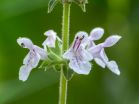(Press-News.org) The exclusive club of explorers who have discovered a rare new species of life isn't restricted to globetrotters traveling to remote locations like the Amazon rainforests, Madagascar or the woodlands of the Congo River basin. Just ask professor John Nelson and alumnus Douglas Rayner -- they're having their membership cards stamped with a long-hidden plant found nowhere but South Carolina.
The new species, dubbed Stachys caroliniana, makes its debut on the international botanical stage next week with a peer-reviewed publication describing its unique characteristics. It has taken some time for S. caroliniana to get its due, but that's not surprising given the rarity of this new example of what is commonly called a hedge-nettle or woundwort.
And rarity is unusual among S. caroliniana's closest relatives. There are about 300 species in the genus Stachys, according to Nelson, the curator of the University of South Carolina's A.C. Moore Herbarium. He calls it a "cosmopolitan genus."
"You can find it in central and western Asia, eastern Africa, Europe, North America and in Central and South America," Nelson says. "We have a lot of it in this part of the world, here in the southeastern U.S."
After graduating from Carolina in 1973, Nelson began to study the numerous species of Stachys in graduate school because he perceived a number of shortcomings in their taxonomy. The established botanical reference work for the region at the time, and still used to this day, was the "Manual of the Vascular Flora of the Carolinas," published by Albert Radford, Harry Ahles and C. Ritchie Bell in 1968.
Annotations within the manual suggesting further studies that might improve the classification scheme convinced Nelson that the genus Stachys needed some help.
"This particular genus -- oh boy -- it just looked like it was kind of a mess," Nelson says. "I picked them to study as a taxonomic problem for my master's study at Clemson, and I've been playing around with them ever since, for 40 years now."
Rayner, who earned both master's and doctoral degrees at Carolina in the mid-1970s, collected the first specimen of what is now known as S. caroliniana in 1977 in the northernmost reaches of Charleston County, south of the Santee River.
It was from a population of plants that has not been relocated since. Nelson came across Rayner's dried and mounted specimen in 1984, when he was working with Rayner at the South Carolina Wildlife and Marine Resources Department (now part of the Department of Natural Resources).
Nelson knew it was something different from the Stachys species he was familiar with, but without more to work with he couldn't make the case that it was a new species. Years later, though, he came across some seemingly familiar plants on Cat Island, which is on the north side of the Santee River in Georgetown County.
"I was just wandering along, the absent-minded botanist, and I thought, 'Well, that's a hedge-nettle, it's definitely Stachys, no doubt about it,'" Nelson says. "And since it's a Stachys and I'm here at the edge of this pond, it must be Stachys floridana, which is a very common weed that grows in people's backyards, including mine up here in Columbia."
But closer inspection showed that it was none of the established species in the botanical literature, and he realized he had discovered another example of what Rayner first found in 1977. With a couple dozen plants to examine, he was able to gather the information to make the case to the scientific community that this was a new species altogether.
The International Botanical Congress has a set of rules by which a new plant name can be established. Nelson and Rayner, now a professor at Wofford College, will publish their results in the Journal of the Botanical Research Institute of Texas on Nov. 25.
Reflecting on the experience, Nelson is particularly pleased to bring such a rare species to the light of day.
"It's one of the most creative things you could ever do. I mean, I didn't make the species, but I guess I'm introducing it to humankind," Nelson says. "It's actually very sobering."
INFORMATION:
A study by a Wayne State University and Children's Hospital of Michigan, Detroit Medical Center research team is shedding new light on the troubling question of whether the drugs often given to HIV-positive pregnant women can cause significant long-term heart problems for the non-HIV-infected babies they carry.
The study recently published in the journal AIDS shows that while the HIV medications have been successful in helping to prevent the transmission of the virus from mother to infant, they are associated with persistently impaired development of heart muscle and ...
An intervention that uses music and games to help preschoolers learn self-regulation skills is helping prepare at-risk children for kindergarten, a new study from Oregon State University shows.
Self-regulation skills - the skills that help children pay attention, follow directions, stay on task and persist through difficulty - are critical to a child's success in kindergarten and beyond, said OSU's Megan McClelland, a nationally recognized expert in child development and a co-author of the new study.
"Most children do just fine in the transition to kindergarten, but ...
We are all familiar with the hassles that accompany air travel. We shuffle through long lines, remove our shoes, and carry liquids in regulation-sized tubes. And even after all the effort, we still wonder if these procedures are making us any safer. Now a new type of security detection that uses terahertz radiation is looking to prove its promise. Able to detect explosives, chemical agents, and dangerous biological substances from safe distances, devices using terahertz waves could make public spaces more secure than ever.
But current terahertz sources are large, multi-component ...
You're at a slumber party with your friends. One friend asks "if a guy at school asked you out, but you weren't really attracted to him, would you go?" You laugh and shake your head no: "Why would I, if he's not my type?"
Or imagine you're at school, sitting in the cafeteria. A guy who you think is attractive but who has some unsuitable personality traits comes up and asks you out. You say yes, even though what you really meant to say was no. "Why did I do that?" you wonder.
According to new research from the University of Toronto and Yale University, rejecting unsuitable ...
As an actress, producer, director and theatre arts lecturer at The University of Texas at Arlington, Julienne Greer knows the techniques that help draw people's deepest emotions to the surface. Now, she's building on her experience and research to help scientists and robotics engineers better understand the human experience so that they can build more responsive robots.
Greer, who holds a master's degree in media arts and a doctorate in humanities, recently authored the paper, "Building emotional authenticity between humans and robots." In it, she referenced a robot named ...
OAKLAND, Calif., Nov. 21, 2014 -- Digoxin, a drug commonly used to treat heart conditions, was associated with a 71 percent higher risk of death and a 63 percent higher risk of hospitalization among adults with diagnosed atrial fibrillation and no evidence of heart failure, according to a Kaiser Permanente study that appears in the current online issue of Circulation: Arrhythmia and Electrophysiology.
Digoxin is a drug derived from digitalis, which has been used for more than a century for heart-rate control in patients with atrial fibrillation, and it remains commonly ...
Patients who receive more cells get significant benefits. That's a key lesson emerging from a clinical trial that was reported this week at the American Heart Association meeting in Chicago.
In this study, doctors treated heart attack patients with their own bone marrow cells, selected for their healing potential and then reinjected into the heart, in an effort to improve the heart's recovery.
In the PreSERVE-AMI phase II trial, physicians from 60 sites treated 161 patients, making the study one of the largest to assess cell therapy for heart attacks in the United States. ...
Scientists have identified four new genes associated with the severe food allergy eosinophilic esophagitis (EoE). Because the genes appear to have roles in other allergic diseases and in inflammation, the findings may point toward potential new treatments for EoE.
"This research adds to the evidence that genetic factors play key roles in EoE, and broadens our knowledge of biological networks that may offer attractive targets for therapy," said study leader Hakon Hakonarson, M.D., Ph.D., director of the Center for Applied Genomics at The Children's Hospital of Philadelphia ...
Study says leopards stay surprisingly close to homes
Leopard home range around humans can be comparable to world's best protected areas
Article available from PLOS ONE
NEW YORK (November 21, 2014) - In the first-ever GPS-based study of leopards in India, led by WCS and partners has delved into the secret lives of these big cats, and recorded their strategies to thrive in human-dominated areas.
The study concludes that leopards in human areas are not always 'stray' or 'conflict' animals but residents, potentially requiring policy makers to rethink India's leopard-management ...
November 21, 2014 -- A study conducted by researchers at Columbia University's Mailman School of Public Health shows that obesity costs the U.S. $8.65 billion per year as a result of absenteeism in the workplace --more than 9% of all absenteeism costs. The consequences of obesity among the working population go beyond healthcare and create a financial challenge not only for the nation but for individual states as well. Findings are published online in the Journal of Occupational and Environmental Medicine.
The study is the first to provide state-level estimates of obesity-attributable ...






